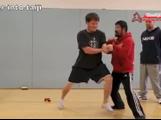‘ Behind Enemy Lines ‘
This is an expression Master Chen uses that I find particularly helpful in understanding the procedure for utilizing the method of fighting taught in the recent video ‘ Move into empty space ‘.
Engage the opponent
… this creates a ‘ front line ‘ like on a battlefield, causing the opponent to commit his troops to maintain that line. This is the same as the demarcation line. The key seems to be to cause the opponent to commit enough of his ‘ forces ‘ and attention to preoccupy him, while you move to step 2
Move into empty space ( Go behind enemy lines )
…. while maintaining the front line, you must use stealth to maneuver, another force to take up a position behind enemy lines, ( beyond the demarcation ( front line ) by moving into the empty space. The keys are, you must maintain the front line, the movement of the secondary forces must neither disturb the front line, nor should they be construed as a threat. In keeping with taiji threory, if the two ends are locked ( non moving ) this requires we move whats in the middle, ideally getting the kua in, (kua to kua)
Anchor into your new position
Your new position at this point becomes the critical pivot, the part you have shifted in behind enemy lines must be established as a lock, it must be anchored to the ground as if set in concrete, and must not move in relation to the ground. Stretch or Rotate At this point you can either lock everything very tightly and rotate, or you can extend and stretch your alignment once the new anchor point is established. Any type of move that is not either a stretch or a rotation will cause you to lose your anchor point. Technically, a stretch with a non moving anchor can be viewed as a rotation, but in this case, as is demonstrated in the video, when Master Chen instructs students to rotate, he has them lock into one piece. — In the video Shifu uses different body parts to go ‘ behind enemy lines ‘ , it doesn’t have to be the kua, he sometimes uses his head or other body parts.
One classical Chen taiji specialization, he has mentioned on several occasions is called ” surprise the top, to take the bottom “, which means you engage the opponent to fight with your upper body then stealthily move the lead foot/leg into strategic position. But this is obviously only one method, he demonstrates many different methods using the same procedure.
http://practicalmethod.com/2015/01/move-into-empty-space-online-video-trailer/


